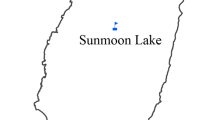Summary
Maximum Entropy Spectral Analysis (MESA) Method is a powerful alternative to the traditionally used Blackman Tukey (BT) and Fast Fourier Transform (FFT) Methods in hydrologic and climatologic time series analysis. Maximum entropy spectra of annual rainfall time series measured at Mangalore and Waltair and monthly flow time series of Godavari and Krishna Rivers in India are presented and compared with the spectra obtained by using BT and FFT methods. A recently developed Bayesian decision rule is applied to determine the length of filters in MESA. Sensitivity of the maximum entropy spectra to the length of filter used is also discussed.
Zusammenfassung
In hydrologischen und klimatologischen Zeitreihenanalysen stellt die Maximale Entropie Spektralanalyse (MESA) eine Alternative zur traditionellen Blackman-Tukey (BT) und schnellen Fouriertransformation (FFT) dar. Es werden die maximalen Entropiespektra der jährlichen Niederschlagszeitreihe in Mangalore und Waltair und die monatlichen Durchflußzeitreihen der Flüsse Godavari und Krishna (Indien) präsentiert und mit den Spektren, die man durch BT und FFT erhält, verglichen. Eine kürzlich entwickelte Entscheidungsregel wurde herangezogen, um die Filterlänge für MESA zu bestimmen. Der Einfluß der Filterlänge auf die maximalen Entropiespektra wird ebenfalls diskutiert.
Similar content being viewed by others
References
Anderson N (1974) On the calculation of filter coefficients for maximum entropy spectral analysis. Geophys 39: 69–72
Blackman RB, Tukey JW (1959) The measurement of power spectra. New York, Dover
Burg JP (1967) Maximum entropy spectral analysis. Proc of 37th meeting of the society of exploration geophysicists, Tulsa, Oklahoma
Burg JP (1972) The relationship between maximum entropy spectra and maximum likelihood spectra. Geophys 37: 375–376
Currie RG (1974) Solar cycle signal in surface air temperature. J of Geophys Res 79: 5657–5660
Damsleth E, Spjotvoll E (1982) Estimation of trigonometric components in time series. J of Am Stat Assoc 77: 381–387
Dixon WJ (ed) Biomedical computer programs. University of California Press, Berkeley, California
Jenkins GM, Watts DG (1968) Spectral analysis and its applications. Holden-Day, San Franciso
Kane RP (1980) Periodicities in the dates of onset of the southwest monsoon over Kerala. Mausam 31: 461–464
Kashyap RL (1977) A Bayesian comparison of different classes of dynamic models using empirical data. IEEE Trans of Automatic Control 22: 715–727
Kay SM, Marple SL Jr (1981) Spectrum analysis — a modern perspective. Proceedings of IEEE 69: 1380–1419
Köppen-Geiger (1971) Klima der Erde. Hermann-Hauk
Lacoss RT (1971) Data adaptive spectral analysis methods. Geophys 36: 661–675
Mizukoshi M (1971) Water balance of monsoon Asia. University of Hawaii Press, Honolulu, Hawaii
Padmanabhan G, Rao AR (1980) Maximum entropy spectral analysis of hydrologic and climatologic data. Technical report no CE-HSE-80-1, School of Civil Engineering, Purdue University, West Lafayette, Indiana
Padmanabhan G, Rao AR (1982) Order selection of AR models of hydrologic time series. Nordic Hydrology 13: 93–104
Pisarenko VF (1982) The retrieval of harmonics from a covariance function. Geophys J of R Astron Soc (UK) 33: 347–366
Rao AR (1980) Statistical characteristics of some Indian hydrologic time series. Mausam (India) 31: 273–286
Rao AR, Padmanabhan G, Kashyap RL (1984) A comparative analysis of recently developed methods of spectral analysis. In: Frontiers in hydrology. Water Resources Publications, Littleton, Colorado
Rao KN, Jagannathan P (1963) Changes in climate. Symposium at Rome organized by UNESCO, Paris, France
Radoski HR, Fougere PF, Zawalick EJ (1975) A comparison of power spectral estimates and applications of maximum entropy method. J of Geophys Res: 619–625
Radoski HR, Zawalick EJ, Fougere PF (1976) The superiority of maximum entropy power spectrum techniques applied to geomagnetic micropulsations. Physics of Earth and Planetary Interiors 12: 208–216
Schickedanz PT, Bowen EG (1977) The computation of climatological power spectra. J of Appl Met 16: 359–367
Smithsonian Miscellaneous Collections (1947) Smithsonian Institution 79, 90 and 105
Smylie DE, Clarke GKC, Ulrych TJ (1973) Analysis of irregularities in the earth's rotation. Methods in Computational Physics 13: 391–430
Tsuchiya I (1971) Walter balance of monsoon Asia. University of Hawaii Press, Honolulu, Hawaii
Ulrych TJ, Bishop TN (1975) Maximum entropy spectral analysis and autoregressive decomposition. Rev of Geophys and Space Phys 13: 183–200
UNESCO Reports (1971) UNESCO, Paris, France
Author information
Authors and Affiliations
Additional information
With 6 Figures
Rights and permissions
About this article
Cite this article
Padmanabhan, G., Rao, A.R. Maximum entropy spectra of some rainfall and river flow time series from southern and central India. Theor Appl Climatol 37, 63–73 (1986). https://doi.org/10.1007/BF00866105
Received:
Revised:
Issue Date:
DOI: https://doi.org/10.1007/BF00866105




